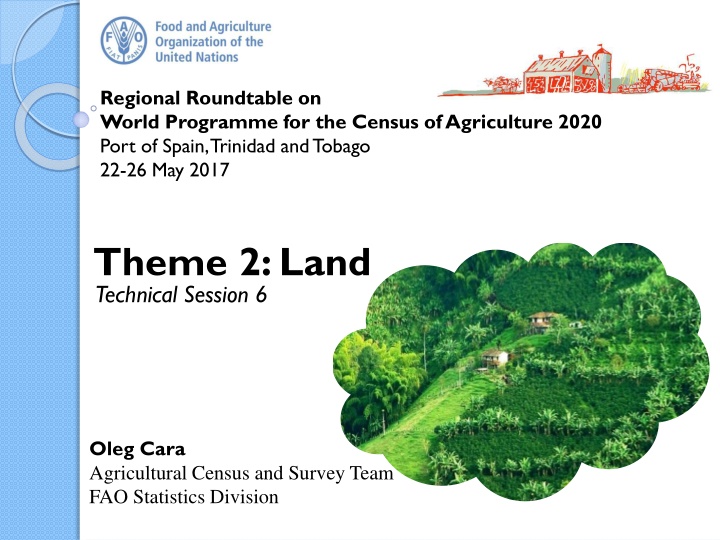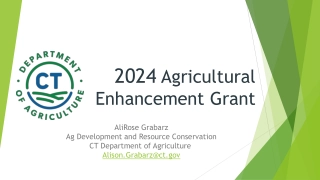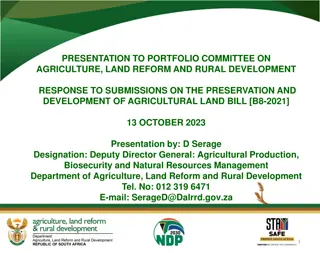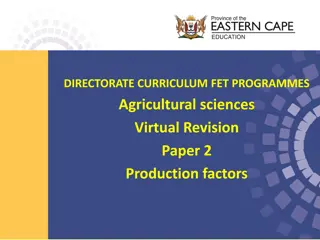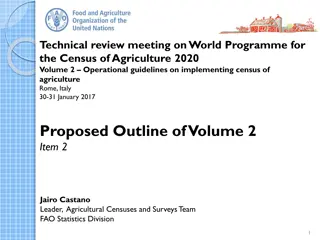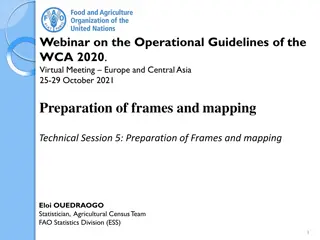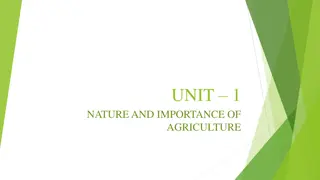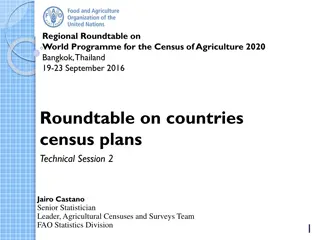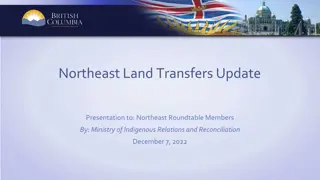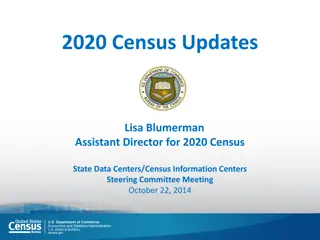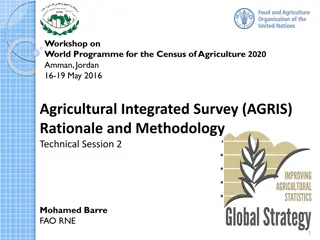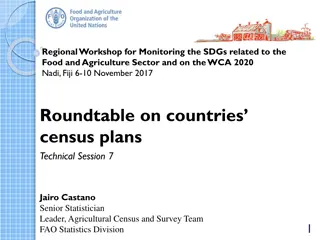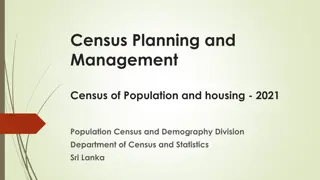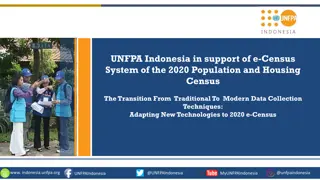Insights into Land Use and Agricultural Census: Regional Roundtable on World Programme for the Census of Agriculture 2020
Explore the crucial theme of land use and its significance in agricultural census analysis, including the updated classification aligned with SEEA. Learn about the essential items at both holding and parcel levels, emphasizing the importance of accurate data for policy-making and understanding land tenure structures.
Download Presentation

Please find below an Image/Link to download the presentation.
The content on the website is provided AS IS for your information and personal use only. It may not be sold, licensed, or shared on other websites without obtaining consent from the author.If you encounter any issues during the download, it is possible that the publisher has removed the file from their server.
You are allowed to download the files provided on this website for personal or commercial use, subject to the condition that they are used lawfully. All files are the property of their respective owners.
The content on the website is provided AS IS for your information and personal use only. It may not be sold, licensed, or shared on other websites without obtaining consent from the author.
E N D
Presentation Transcript
Regional Roundtable on World Programme for the Census of Agriculture 2020 Port of Spain, Trinidad and Tobago 22-26 May 2017 Theme 2: Land Technical Session 6 Oleg Cara Agricultural Census and Survey Team FAO Statistics Division
Contents Background Importance of the theme Items: type, reference periods, importance of the items, concepts and special characteristics Country experiences 2
Background In Theme 2, the most important change in respect to previous programmes is that land use classification was updated to be consistent with the System of Environmental-Economic Accounting (SEEA) Central Framework Land use at parcel level is a new item for this theme The theme comprises 4 items at holding level and 7 items at parcel level Out of them, three items are essential items, one of them is also a frame item 3
Importance of the Theme The area operated by holdings is a critical element in census analysis. Different types of actual use of land define the structure of agriculture of a country. Structure of land tenure is important in any analysis at aggregate level. Census data about parcellation of land constitute valuable information for policy making at agricultural and rural levels. 4
Items Theme 2 comprises the following items: For the holding: For each parcel 1. 2. 3. 4. 5. 6. 7. Location Area Land use Land tenure Terms of rental Use of shifting cultivation Number of years since cleared 1. 2. Total area of holding. Area of holding according to land use types. Area of holding according to land tenure types. Presence of soil degradation 3. 4. 5
Item 0201: Total area of holding Type: Essential and frame item Reference period: census reference day Concept: Total area of holding is the area of all the land making up the agricultural holding. It includes all land operated by the holding regardless to title or legal form. Caveat: land owned by the holder and rented TO others should not be included. On the contrary: area rented FROM others for agricultural production purposes need to be included in the holding area. 6
Item 0201: Total area of holding (contd) Are there landless holdings? Yes. With an insignificant or even zero land area the holding could have an agricultural activity, e.g.: holdings without land used for agricultural production, raising livestock on communal land. The holding s land may consist of one or more land parcels. The parcels can be located in one or more separate areas or administrative units, providing they are part of the same economic production unit and share the same production means. 7
Item 0201: Total area of holding (contd) What types of land should be included? Land used for growing crops, meadows and pastures. Land temporarily fallow Forest and other wooded land Bodies of water Farmyards and land occupied by farm buildings Land for which a holding only has the right on the products of the trees growing on it. 8
Item 0202: Area of holding according to land use types Type: essential item Reference period: census reference year Concept: It is the breakdown of the total area reported in the previous item (it means the total area of the holding operated as of the census reference day), according to its use during the census reference year. Note: Land use should be distinguished from land cover . 9
Land use classes Arable Land Land under temporary crops Land under temporary meadows and pastures Land temporarily fallow Cropland Agricultural land Land used for agriculture Land under permanent crops Land under permanent meadows and pastures Land under farm buildings and farmyards Forest and other wooded land Area used for aquaculture Other land. 10
Basic land use classes: main concepts Land under temporary crops: all land used for crops with less than one year growing cycle. Land under temporary meadows and pastures: Land temporarily (less than 5 years) cultivated with herbaceous forage crops for mowing or pasture. Land temporarily fallow: arable land at prolonged rest (at least one year, usually no more than 5 years) before re-cultivation. Land under permanent crops: land cultivated with long-term crops which do not have to be replanted for several years. Land under permanent meadows and pastures: land used permanently (5 years or more) to grow herbaceous forage crops, through cultivation or naturally. Land under farm buildings and farmyards: surfaces occupied with operating farm buildings (barns, silos, stables, etc.) 11
Item 0203: Area of holding according to land tenure types Type: essential item Reference period: census reference day Concept: It is the breakdown of the total area of holding, according to specific land tenure types. Land tenure refers to the arrangements or rights under which the holder operates the land making up the holding. 12
Land tenure types Legal ownership or legal owner-like possession: The holder (or members of the holder s household) possess title of ownership. The land is held under conditions that enable it to be operated as if legally owned by the holder or members of the holder s household (hereditary tenure, perpetual or long-term lease with nominal or no rent) The land is held under a tribal or traditional form of tenure which is legally recognized by the state. Rented from someone else: Non-legal ownership or non-legal owner-like possession: Land is rented or leased from other persons (including state agencies), usually for a limited period of time under some of different rental conditions: an agreed sum of money and/or produce, for a share of the produce or in exchange of services. Land may also be granted for free. The holder (or members of the holder s household) have operated the land without interruption for a long period without any form of legal ownership, title, long-term lease or payment of rent. The holder is operating land owned by the state without any legal rights. Land is operated under a tribal or traditional form of tenure which is not recognized by the state and it is outside the realm of the law. Other types Squatting Transitory tenure forms (e.g. trusteeship) Land received by members of collective holdings for individual use Land under inheritance proceedings 13
Item 0204: Location (for each parcel) Type: additional item Reference period: census reference day Concept of parcel: Parcel is any piece of land, of one tenure type, entirely surrounded by other land, water, road, forest or other features not forming part of the holding or forming part under a different land tenure type. A parcel may consist of one or more fields or plots adjacent to each other. Concept of field: Field is a piece of land in a parcel separated from the rest of the parcel by easily recognized demarcation lines. Concept of plot: It is a part or whole of a field on which a specific crop or crop mixture is cultivated. 14
Items 0205, 0206, 0207, 0208: Area, land use land tenure and terms of rental (for each parcel) Type: additional items Items 0205 and 0207: same concepts and definitions as before Item 0206 Land use: new item (see similar holding-level item 0202) Item 0208: Terms of rental (for each rented parcel): Reference period: census reference day Forms of rental arrangements: For an agreed amount of money or produce For a share of produce In exchange of services Under other rental agreements. 16
Item 0209: Use of shifting cultivation (for each parcel) Type: additional item Reference period: census reference year Concept of shifting cultivation: It is a farming practice whereby a particular piece of land is cultivated for some years and then abandoned for a period sufficient to restore fertility by natural vegetative growth before being re-cultivated. Caveat: Data are collected on whether or not the parcel has been cultivated using shifting cultivation practices during the census reference year. 17
Item 0210: Number of years since cleared (for each parcel) Type: additional item Reference period: census reference day Purpose: The purpose of this item is to better understand the extent of recent land clearances. Suggested classes: In the last year 1-3 years ago 4 or more years ago. 18
Item 0211: Presence of soil degradation: type and degree (for the holding) Type: additional item Reference period: census reference day Concept of soil degradation: It refers to the decline in soil quality due to natural processes or, more commonly, improper use by humans. Purpose: To get the holder s overall impressions of the extent to which land degradation is present on holding and its effect in agricultural production. Suggested categories for types of soil degradation Soil erosion Chemical degradation Physical deterioration Suggested categories for degree: None Light Moderate Severe 19
Country experiences All countries collect holding-level information on the items included in this Theme. However for the items about land use, two main practices has been observed: Ask the respondent about the land use categories on holding; Recompose the land use categories from the answers provided for other questions in the questionnaire. Both methods have pros and cons: To collect information directly from the holder (or other respondent) allows for cross-checking with the answers provided in other questions related to area of crops, meadows and pastures, etc. On the other hand, it overcharges the questionnaire asking for data that can be obtained from other questions. Re-composition from the other answers discharges the questionnaire of questions but it may not allow reconstituting all land use categories and does not allow the above referred cross- checkings. In practice often combination of these methods is used 20
Country experiences (contd) Saint Lucia: Agricultural Census 2007 In Section D Land of the Agriculture Censal Questionnaire - CAF A the following information was collected: Total area of holding Number of parcels of land For each parcel the following information was collected: Location of parcel Area of parcel (acres) Land tenure type (owned, family land, rented/leased, squatting, other) For rented/leased and squatting land: a)private; b) government Area of land according to land use types (for each parcel): Area under permanent crops Area under temporary crops Area under permanent meadows and pastures Area under temporary meadows Fallow land Forest and woodland Other lands 21
Many thanks 22
